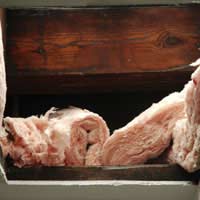Finding Funding to Insulate Your Home

Insulating your home is possible one of the easiest and most cost effective ways of making your home more energy efficient.It is also a good way to start saving money on household fuel bills. In fact, more than half of the heat you use in your home is lost through walls, floors and lofts.There are, however, grants available to homeowners to help with the cost of insulating your home.
A Helping Hand
As a homeowner, or a private tenant, and you are receiving benefits or tax credits, or are over the age of 70, you are probably eligible to receive a grant to pay for loft and cavity wall insulation.And, if you wanted to be even more energy efficient, the government also provide grants of £400 to pay for solar panel installation.If you don't think you are eligible for a full grant, don't worry, you could still receive a grant that will cover 50 per cent to 70 per cent of the cost - this could save a homeowner of a three bedroom detached house an average of £500.
Feeling Hot, Hot, Hot
Local authorities have been under obligation to reduce energy usage and carbon emissions by 30 per cent per area in a bid to reduce climate change since the Home Energy Conservation Act (HECA) was introduced in 1996.Various local authorities now have structured projects in place that work with residents to help deliver these energy and carbon requirements.The Energy Savings Trust acts as the overseeing body and it is through them that local authorities can gain access to funding to help with the installation of loft and wall insulation.
Over the past 10 years, local authorities have made significant advances and, on a more personal note, individuals who have taken advantage of the funding provided to insulate their homes have saved an average of £250 on their fuel bills per year.
Upstairs, Downstairs
It is estimated that around 25 per cent of the heat that is produced in one single home escapes through the roof. By insulating your loft you can make significant savings on your fuel bill because it acts as a blanket, keeping the heat in the living space below.The standard requirement is approximately 11 inches of loft insulation in your home. If you have up to six inches already, then you are eligible for a grant to install the surplus.This will also include the cost of lagging all the cold water tanks and pipes.Another Brick in the Wall
The loft, however, isn't the only place where heat from inside the home escapes from. Heat produced in the home also escapes through the walls, in fact, up to 35 per cent is lost this way.By insulating the walls, you could save a further £130-£160 per year.We have been hearing a lot about cavity wall insulation recently. It works to keep an even temperature within the home and prevent condensation on walls and ceilings. This helps to keep homes cool in the summer and warm in the winter.The reason we have been hearing so much lately is because houses that were built before 1935 might not have suitable wall insulation.
If your house was built before this time, you could be eligible for grant for cavity wall insulation. Now, this sounds like a messy job. It is, however, very simple and can be installed through small holes drilled on the outside of the property. The cavity wall insulation is then injected in through the holes and the holes are filled in to match the existing brick.
- Feed-in Tariff Grant: Solar Panels and Wind Turbines
- Wellcome Trust Arts Awards
- Regional Innovation Grants
- Research and Development Grants
- Grants Under the Boiler Scrappage Scheme
- Getting Financial Assistance for Home Repairs
- Getting Financial Help With Heating Your Home
- Getting Financial Help With Utility Bills
- Funding for Home Improvements


Re: Getting Help with Funding for School Trips
My nephew has been invited in a school trip that even with a pupil premium discount will cost £1000. Are there…
Re: Getting a Renovation Grant
Hi I’m living in an inherited property from my grandmother I’ve hired someone to do mould removal but I was hoping for financial help…
Re: Eligibility for Nature Conservation Grants
Hi have secured a spot for a wildlife conservation expedition and would appreciate any help and information…
Re: Getting a Renovation Grant
need carpets for my bedroom and frontroom
Re: English Heritage Grants
I HAVE BEEN RENTING 32 SEVERN SIDE SOUTH, BEWDLEY DY12 2DX IN A CONSERVATION ARE BUT NOW HAVE THE CHANCE TO BUY IT. A SURVEYOR HAS PROVE…
Re: Getting a Renovation Grant
Hi I am widow my probate is under process.I am on benefit .I am age is 55 years .l have mold and damp.I have not got money to fix the…
Re: Getting a Renovation Grant
Please could you advice me on any grants for renovation work for older people please
Re: Getting a Renovation Grant
I am buying a property that requires new windows & also a new heating system. Is there any grants to i am entitled to to assist with…
Re: Qualifying for the Rural Enterprise Scheme (RES)
We currently have planning permission on our outbuildings I was just wondering if there’s any help with…
Re: Getting a Renovation Grant
I am 61 years old, my husband is 60. We live in a semi detached house. With our daughter. I am on Universal Credit and PIP. My…